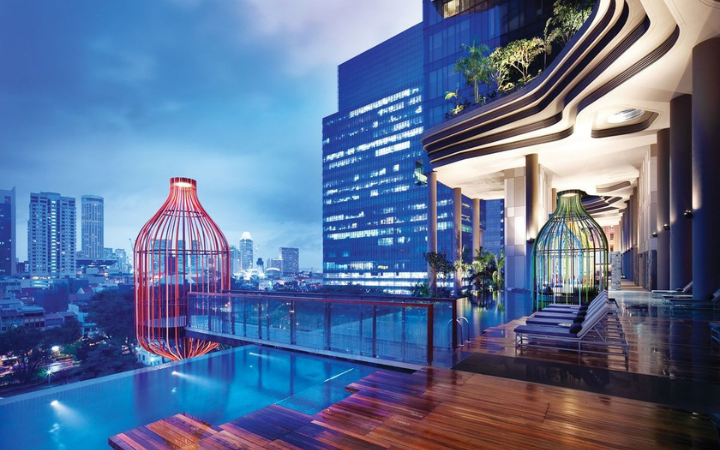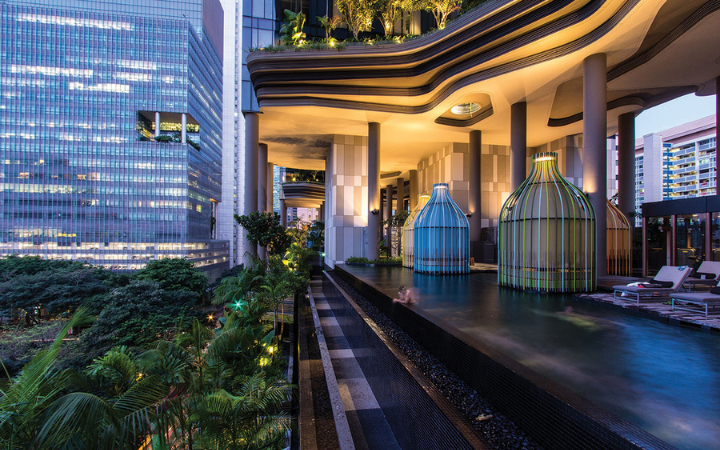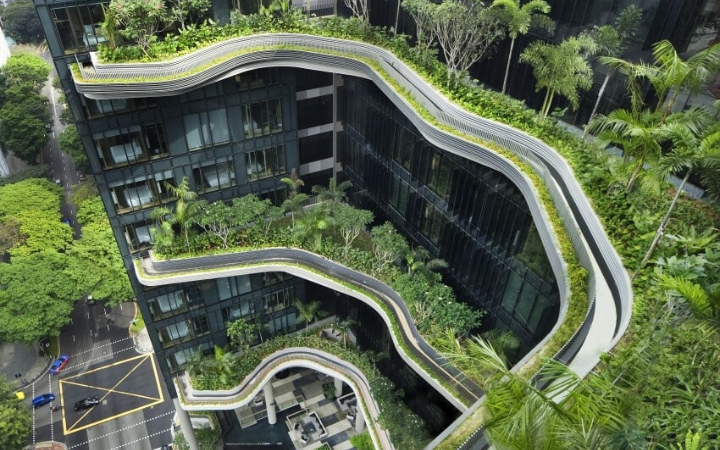INSIGHTS
Singapore's first hotel-in-a-garden

For business travellers, planners seeking incredible event spaces, or teams looking for incentive destinations, Singapore's PARKROYAL on Pickering exceeds expectations on every level.
This iconic hotel is an architectural masterpiece of sustainability and design. Its hotel-in-a-garden concept redefines what a modern luxury hotel can be. Centrally located in the heart of Singapore's bustling central business district (CBD), between Chinatown and the Singapore River, PARKROYAL on Pickering combines convenience with peace.
Boasting 15,000 square meters of lush, four-story-high sky gardens, reflecting pools, waterfalls, and cascading greenery, the hotel's foliage covers over 200% of its total land area. Designed by Singapore-based architecture firm WOHA, who also designed the PARKROYAL Collection Marina Bay, this Pan Pacific gem embraces its surroundings, appearing almost as an extension of Hong Lim Park.

Green features and innovations
Green and blue glass panels increase energy efficiency while allowing natural light to fill the property.
Cascading plants cool west-facing walls, reducing the energy required to maintain comfortable guestroom temperatures.
Over half of the guestroom corridors are designed as open garden areas, offering fresh air and ample natural light.
The recreational rooftop areas and Urban Farm double as natural insulation for the building's upper levels.
An above-ground car park eliminates the need for energy-intensive excavation, mechanical ventilation, and artificial lighting.
The extensive landscape areas are designed to be self-sustaining and rely minimally on precious resources.
Dining
Business or pleasure, great food fuels success.
The Lime Restaurant and Bar offers buffet or la carte dining and signature cocktails—ideal for tasing international dishes, networking or unwinding. Guests can also choose from a range of sweets and savoury treats from The Lime Pâtisserie.
The Urban Farm, located on the top of the building, celebrates another step towards a more sustainable hospitality. It has over 50 varieties of vegetables, fruits, herbs, and edible flowers that fuel the Lime Restaurant and Bar.
Sustainability
Recycling and energy strategies
Separate plastic, glass, and paper bins are located in every guest room and across the property to provide responsible waste management.
Photo sensors monitor light levels, dimming when possible to conserve energy, while motion sensors in staircases reduce unnecessary usage.
The first development in Singapore to adopt Cobiaz technology, reducing concrete use by incorporating recycled plastic void formers.
Carepark smart controls minimise energy use by adjusting ventilation based on carbon monoxide and carbon dioxide levels.
Water saving techniques
Automatic built-in sensors in landscaped areas shut off irrigation systems during adequate rainfall.
A centrally managed chiller system optimises cooling efficiency through advanced control strategies.
The hot water system is designed to use air-to-water heat pumps with a coefficient of performance of at least 4.5 (or better).
Rainwater harvesting and recycled NEWater helps reduce overall water consumption.

Landscape
A biodiverse oasis
50 plant varieties are carefully curated and spread across the hotel to create a vibrant, tropical environment.
Layered greenery includes dense Monsteras and Alocasias to textured ferns and palm varieties.
Shade-loving ferns and partial-shade palms address varying light and wind conditions around the building's four sides.
A mix of tall shade trees, flowering plants, creepers, and shrubs provides a balance of looks and functionality.
Planet-friendly and low-maintenance
The vast greenery absorbs heat, shades hard surfaces, and improves air quality through evaporative transpiration.
Ferns, Mondo grass, and Euterpe Palms were chosen for their pest-resistant properties and minimal maintenance needs.
A timer-controlled auto-irrigation and fertigation system provides precise water and nutrient delivery, keeping plants thriving with minimal resources.
Design that embraces nature
Bucida trees and Calathea lutea shrubs complement the building's architectural curves with fine, broad-leaved textures.
Heliconias, Frangipani trees, and Ficus lyrata enhance the visual appeal, adding vibrant hues to the verdant landscape.
Vietnam Leaf-Flower and Lee Kuan Yew creepers trail down the building, softening its urban structure with natural elegance.
A front-runner in green high-rise hotels, PARKROYAL on Pickering’s commitment to planet-friendly techniques makes it a global leader in sustainable urban design. Perfect for travellers and businesses seeking centrally located luxury and responsibility.